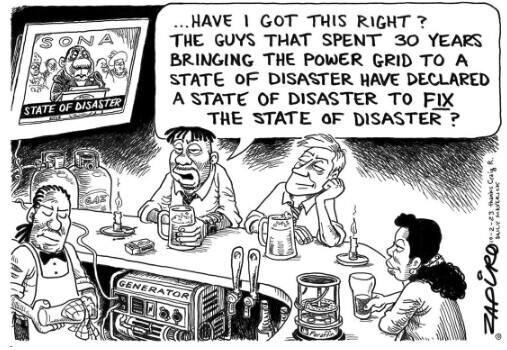Deleted … found a more appropriate spot to use it.
Enjoyed this!
Me too… way more than I should have.
I agree with them, the fact that Dr Zol is anywhere near this gives me the hibbie jibbies.

I checked the DA press releases. They are right. They did call for that (the media didn’t report it all that accurately though, as they do). The thing is, that in itself may have been a little irresponsible. There is no provision in law for a “ring fenced” state of disaster. The better option would have been not to declare your support for anything remotely named like the thing that actually IS in the law.
and…
In other words, as I see it, new thinking must be applied. At least they try.
Skerp ![]()
Groetnis
That’s a little confusing. Section 44 has to do with the division of authority: What can be done by parliament, vs what has to be done by the national council of provinces. Schedules 4 and 5 expands on what functions belongs to whom. 44(2) merely allows parliament to intervene in provincial matters, should it be absolutely necessary (eg, national security).
The long and the short of it, I suppose, is that parliament could have made a law, and it could have been treated with the required urgency and passed quickly. Other democracies do it all the time.
Residential customers
- The initiative will be available later in the year in addition to the existing credit offset against the monthly account.
- A PV system and inverter is also required.
- Installers must apply to the city to authorise the system for grid connection. No authorisation fee is charged by the city.
- Authorised customers need to install a specialised Advance Metering Infrastructure or AMI meter. The cost is approximately R12 850, but the city is looking to bring down the cost for households.
- A monthly Advance Metering Infrastructure (AMI) administration fee will be applicable.
- If you are not on the Home User tariff already, you will be moved to the Home User tariff.
- Credit rollout will be later in 2023.
- Residential customers will be credited with 78,98c p/kWh (2022/23), plus 25c p/kWh incentive for each kWh fed into the City grid.
- Credit will be offset against total monthly municipal account and all accounts linked to the same business partner number.
- Any remaining credit will be paid to the customer by the city. Payments will only be made on amounts over R1 000. Amounts of less than R1 000 will be held back until the total exceeds R1 000 and will then be paid once per year.
- The amount of energy that they can produce is limited by the size of their system, which is limited by the size of their connection to the city’s grid.
“If 8 GW of solar, 5 GW of wind and 3 GW of storage can be added over the next two years, which would be difficult but possible, South Africa will no longer be experiencing loadshedding, the prices of electricity will stabilise, there will be headroom to maintain the coal fleet and we will not need to burn nearly as much diesel to keep the lights on.
“In this scenario, with the coal fleet producing 175 TWh, and with the recommended additions of PV, wind and storage, the existing OCGT fleet would only need to run at less than a 2% capacity factor, and the diesel bill would be less than R2.5-billion for the year.
“Therefore, that should be the priority of the National Energy Crisis Committee,” Mallinson avers. ![]()
" Now, there is something about Germany that you need to know. The average sun hours per day in Stuttgart, which is about a third of the way up from the southern border is 3.33 hrs/day. In German terms, this is good. In Bremen, about two-thirds of the way up the country, the usable time for PV systems is on average about two hours per day. Compare and contrast South Africa which has about six hours of PV usable solar per day, on average. So just bear that in mind; SA is about three times as effective, for geographical reasons, as Germany.
Nevertheless, Germany now has about 1.6-million solar installations, which produce about 10% of Germany’s power. Together, the home systems and the more formal solar plants produced about 38.3GWh of power, off a total installed capacity of around 58GW. That is more than Eskom’s entire nominal capacity of 44GW. I apologise if I have prompted your eyes to glaze over with all of the GWhs.
Yup, agree 100%
Do you know what the COCT pays ESKOM for a kWh?
My electrons are equally as good.
I am going to play the “electronist” card. ![]()
Last I heard, may have increased, was like R0.78c per kW excl VAT.
The rates will be seasonal, as will the maximum demand rates.
There will be a fixed transmission rate as well.
But, on the face of it, the COCT are offering ballpark what they are paying ESKOM in the Low season. (Which is Sept-May).
This is a pity because, at the size of the typical domestic system, exporting is not viable, and the COCT has no headroom to better the offer.
What this means, mathematically, is that the EAF is a continuum. There cannot be a discontinuity – also known as a step change – in the EAF trend.
“To increase Eskom’s EAF, there must first be a slowdown. It then has to bottom out, stabilise, and start to rise. This process will take several years,” he said.
“It is mathematically impossible for this to happen in the 2023/2024 or 2024/2025 financial years,” Yelland said.
Blockquote
Maths don’t lie
I think what fascinates me more is the predictability of people. You can bank on it so much that you can slap a mathematical model on top and actually get accurate results from it.
Yesterday, for whatever reason, I was reminded of Lanchester’s equations for modelling battles. The basics of it is pretty simple: The larger the army, the larger the rate of demise of their opponents. You will have a factor k, relative to their strength (weapons, training, etc), and you will generally have such a factor on each side, because the armies may not be matched in skills, technology, or numbers. But once you get these numbers right, it quite accurately predicts the outcome (but as with all such models, you make the assumption that the function is continuous, even though people are strictly discrete, half-a-people generally doesn’t fight very well).
An interesting variation of this was when someone applied these laws on a battle that started out in the open fields, but ended up in an enclosed space (when the enemy invaded the castle). The numbers suddenly shifted, as the defending army now had the advantage of knowing the layout better, and the enclosed space forced one-on-one battle, nullifying the advantage of larger numbers.
This morning we went out into morning traffic again, as we do every day on the school run, and observed that traffic was much worse on the usual route. We opined that Load Shedding likely has something to do with it: People are taking this alternate route to skip the non-working traffic light at the bottom. But then we also wondered why today was so much worse than other days when we also had a 6AM-8AM slot (which, as TTT will tell you, is a thing that happens in Cape Town, you tend to get the same schedule three days in a row). My theory around this is another mathematical modelling rule: Ideas spread proportional to the number of people who knows about it (in other words, the formula is of the form P = ce^kt), which pretty much predicts a rapid increase in traffic on “better” routes, as soon as people start talking about it.
Moral of the story: Don’t tell your friends about the better routes!
